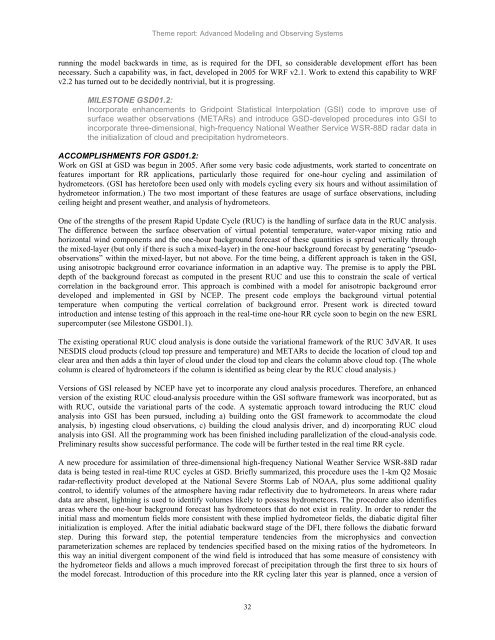Scientific Theme: Advanced Modeling and Observing Systems
Scientific Theme: Advanced Modeling and Observing Systems
Scientific Theme: Advanced Modeling and Observing Systems
Create successful ePaper yourself
Turn your PDF publications into a flip-book with our unique Google optimized e-Paper software.
<strong>Theme</strong> report: <strong>Advanced</strong> <strong>Modeling</strong> <strong>and</strong> <strong>Observing</strong> <strong>Systems</strong><br />
running the model backwards in time, as is required for the DFI, so considerable development effort has been<br />
necessary. Such a capability was, in fact, developed in 2005 for WRF v2.1. Work to extend this capability to WRF<br />
v2.2 has turned out to be decidedly nontrivial, but it is progressing.<br />
MILESTONE GSD01.2:<br />
Incorporate enhancements to Gridpoint Statistical Interpolation (GSI) code to improve use of<br />
surface weather observations (METARs) <strong>and</strong> introduce GSD-developed procedures into GSI to<br />
incorporate three-dimensional, high-frequency National Weather Service WSR-88D radar data in<br />
the initialization of cloud <strong>and</strong> precipitation hydrometeors.<br />
ACCOMPLISHMENTS FOR GSD01.2:<br />
Work on GSI at GSD was begun in 2005. After some very basic code adjustments, work started to concentrate on<br />
features important for RR applications, particularly those required for one-hour cycling <strong>and</strong> assimilation of<br />
hydrometeors. (GSI has heretofore been used only with models cycling every six hours <strong>and</strong> without assimilation of<br />
hydrometeor information.) The two most important of these features are usage of surface observations, including<br />
ceiling height <strong>and</strong> present weather, <strong>and</strong> analysis of hydrometeors.<br />
One of the strengths of the present Rapid Update Cycle (RUC) is the h<strong>and</strong>ling of surface data in the RUC analysis.<br />
The difference between the surface observation of virtual potential temperature, water-vapor mixing ratio <strong>and</strong><br />
horizontal wind components <strong>and</strong> the one-hour background forecast of these quantities is spread vertically through<br />
the mixed-layer (but only if there is such a mixed-layer) in the one-hour background forecast by generating ―pseudoobservations‖<br />
within the mixed-layer, but not above. For the time being, a different approach is taken in the GSI,<br />
using anisotropic background error covariance information in an adaptive way. The premise is to apply the PBL<br />
depth of the background forecast as computed in the present RUC <strong>and</strong> use this to constrain the scale of vertical<br />
correlation in the background error. This approach is combined with a model for anisotropic background error<br />
developed <strong>and</strong> implemented in GSI by NCEP. The present code employs the background virtual potential<br />
temperature when computing the vertical correlation of background error. Present work is directed toward<br />
introduction <strong>and</strong> intense testing of this approach in the real-time one-hour RR cycle soon to begin on the new ESRL<br />
supercomputer (see Milestone GSD01.1).<br />
The existing operational RUC cloud analysis is done outside the variational framework of the RUC 3dVAR. It uses<br />
NESDIS cloud products (cloud top pressure <strong>and</strong> temperature) <strong>and</strong> METARs to decide the location of cloud top <strong>and</strong><br />
clear area <strong>and</strong> then adds a thin layer of cloud under the cloud top <strong>and</strong> clears the column above cloud top. (The whole<br />
column is cleared of hydrometeors if the column is identified as being clear by the RUC cloud analysis.)<br />
Versions of GSI released by NCEP have yet to incorporate any cloud analysis procedures. Therefore, an enhanced<br />
version of the existing RUC cloud-analysis procedure within the GSI software framework was incorporated, but as<br />
with RUC, outside the variational parts of the code. A systematic approach toward introducing the RUC cloud<br />
analysis into GSI has been pursued, including a) building onto the GSI framework to accommodate the cloud<br />
analysis, b) ingesting cloud observations, c) building the cloud analysis driver, <strong>and</strong> d) incorporating RUC cloud<br />
analysis into GSI. All the programming work has been finished including parallelization of the cloud-analysis code.<br />
Preliminary results show successful performance. The code will be further tested in the real time RR cycle.<br />
A new procedure for assimilation of three-dimensional high-frequency National Weather Service WSR-88D radar<br />
data is being tested in real-time RUC cycles at GSD. Briefly summarized, this procedure uses the 1-km Q2 Mosaic<br />
radar-reflectivity product developed at the National Severe Storms Lab of NOAA, plus some additional quality<br />
control, to identify volumes of the atmosphere having radar reflectivity due to hydrometeors. In areas where radar<br />
data are absent, lightning is used to identify volumes likely to possess hydrometeors. The procedure also identifies<br />
areas where the one-hour background forecast has hydrometeors that do not exist in reality. In order to render the<br />
initial mass <strong>and</strong> momentum fields more consistent with these implied hydrometeor fields, the diabatic digital filter<br />
initialization is employed. After the initial adiabatic backward stage of the DFI, there follows the diabatic forward<br />
step. During this forward step, the potential temperature tendencies from the microphysics <strong>and</strong> convection<br />
parameterization schemes are replaced by tendencies specified based on the mixing ratios of the hydrometeors. In<br />
this way an initial divergent component of the wind field is introduced that has some measure of consistency with<br />
the hydrometeor fields <strong>and</strong> allows a much improved forecast of precipitation through the first three to six hours of<br />
the model forecast. Introduction of this procedure into the RR cycling later this year is planned, once a version of<br />
32
















